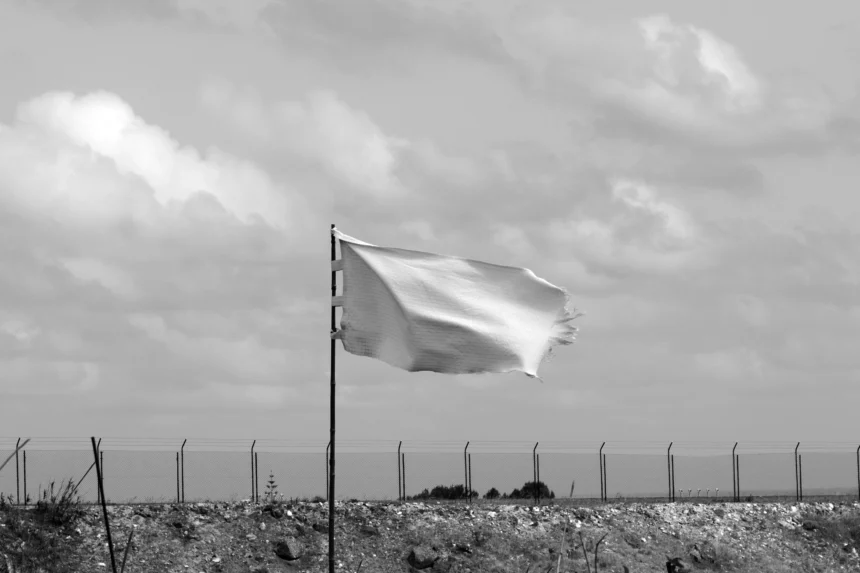When you see a white flag, most people think “surrender.” But throughout history, it’s been used for a lot more than that. “It might mean you want to parley,” says James Ferrigan, a consulting vexillologist (that’s a flag expert) and an officer for the North American Vexillological Association.
“It also could mean, in the midst of something, that you want to have a truce. Maybe it’s to bury your dead, and so it’s neither a parley nor a negotiation nor a surrender, it’s just a temporary respite.”
At its core, the white flag means: “Don’t attack me.” Military officials have waved it to safely contact enemies while civilians have used it to show they’re peaceful and not fighters. But its journey through history is actually pretty interesting.
The Early Days
Trying to figure out where the white flag came from isn’t easy. Ancient examples are rare. Roman historian Livy wrote that during the Second Punic War (218–201 B.C.), Carthaginians used “bands of white wool and branches of olive” to signal peace.
Later, in A.D. 69, the Roman historian Tacitus noted a Roman civil war faction also used white bands and olive branches.
Why white? Ed Watts, a history professor at UC San Diego, says Mediterranean people wore white cloth when worshipping gods. “Displaying it during a war may have been a way of saying: ‘We are putting ourselves at your mercy, and asking for the protection of the gods,’” Watts explains.
After that, the trail goes cold until the 16th century. The first recorded use of the term “white flag” appears in 1578. English sailor George Best described Inuit people signaling peaceful contact with a white flag made from “bladders sowed together with the guts and sinewes of beasts” while he explored the Northwest Passage.
In 1625, Dutch jurist Hugo Grotius mentioned the white flag in his influential book on laws of war and peace, calling it a way to ask for a parley—basically a conversation between enemies. By this point, waving a scrap of white cloth had started to gain meaning beyond practicality.
Practicality Meets Symbolism
Why did a plain white flag stick around? Partly, it was just practical. Undyed cloth was easy to get, came from soldiers’ clothes or supplies and stood out from the colorful flags armies carried. By the late 1800s, the white flag had become widely recognized as a military symbol. It even played a role in the end of the U.S. Civil War.
When Confederate General Robert E. Lee decided to surrender to Union General Ulysses S. Grant at Appomattox Court House on April 9, 1865, he sent a Confederate officer across enemy lines with a dish towel as an impromptu white flag.
That towel, now at the Smithsonian National Museum of American History, was chosen simply because it was at hand. Ferrigan notes, “The intent when you [go into battle] is that you’re going to be victorious. Carrying a predesignated truce flag would be detrimental to morale.”
Official Recognition
The white flag became more than just tradition during the First Hague Conference of 1899.
An annex to one of the Hague Conventions stated that anyone carrying a white flag to communicate with a military rival “has a right to inviolability,” meaning they shouldn’t be attacked. But there was a catch: if they misused it to betray or trick the enemy, that protection was gone.
The symbol stuck through both World Wars. During the 1914 Christmas Truce, French soldier Gervais Morillon wrote home that German soldiers “waved a white flag and shouted ‘Kamarades, Kamarades, rendez-vous.’”
In World War II, Nazi officers used a white flag at the Battle of the Bulge to offer surrender. U.S. General Anthony McAuliffe famously responded with just one word: “Nuts!” causing some confusion among the Germans. One American officer even reportedly explained it meant “Go to hell.”
Civilians and Hostages
White flags aren’t just for soldiers. Regular people and even hostages have waved them to stay safe during fights. But it doesn’t always work. Sometimes soldiers have ignored the white flag and even attacked the people holding it, even though it’s supposed to mean “please don’t hurt us.”
Human rights groups and politicians have raised alarms about these incidents, emphasizing that the victims were civilians and that the white flag has been a recognized symbol for hundreds of years. For anyone waving it, it’s meant to signal truce, peace, protection or a desire for dialogue, not weakness.
From Roman battles to fights today, the white flag has always meant the same thing: hoping for some peace, even just for a little while. It doesn’t matter if it’s a rag or a real flag—the message is the same.



